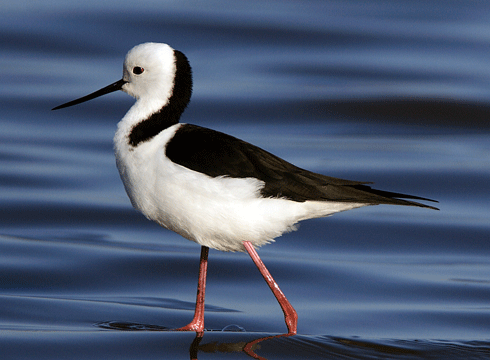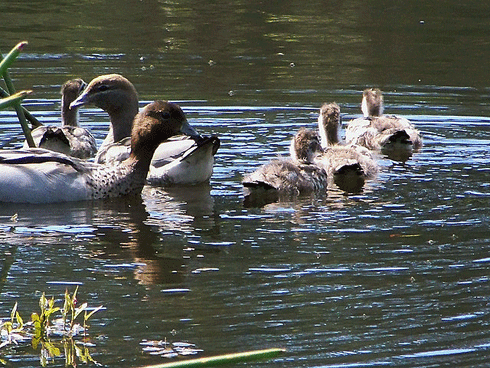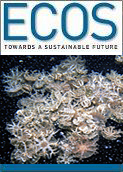
|
Published: 17 September 2012
Sewage ponds a refuge for wetland-deprived waterbirds
By 2080, coastal wetlands may occupy 70 per cent less of the planet than they do today. Sea-level rise, triggered by climate change, will account for around one-third of the decline.1 The impact of this loss on waterbirds, the most recognisable group of wetland fauna, is unknown. But, we believe that certain wetlands – particularly waste treatment ponds – are important for many waterfowl species.

|
|
A black-winged stilt at Werribee, Victoria, the location of Melbourne’s Western Treatment Plant – Werribee is a renowned destination for bird-lovers. Credit:
scienceimage/John Manger
|
Human activities have already deprived the world of around half its natural wetlands.2 This has had a dramatic effect on the wildlife populations that depend on those wetlands for their existence.
Our research group at the University of Melbourne set out to determine how waterfowl in south-eastern Australia used different types of wetlands. We did this with the aid of a database derived from the Summer Waterfowl Count, an initiative of the Victorian government.3
The government established the Summer Waterfowl Count to:
-
monitor waterfowl numbers
-
locate local concentrations of breeding waterfowl and rare and endangered species, such as freckled duck
-
manage duck hunting.
The database contains counts from around 300 wetlands since 1987. Many of the wetlands are either within the Murray–Darling Basin, or provide a refuge for birds from the basin during drought. The Murray–Darling Basin is an important waterfowl breeding area in Australia, particularly for south-eastern Australian species.

|
|
Lake Cargelligo treatment works in NSW provides habitat for a wide range of waterbird species. Credit:
Tim Dolby
|
For our study, we selected a sample of 133 wetlands that each had at least 10 years of data recorded. Within the sample, we surveyed five different types of wetland from 1987 to 2009: deep marsh, open water (the predominant type), permanently saline, semi-permanently saline, and waste stabilisation ponds (such as Melbourne’s Western Treatment Plant at Werribee).
Our analysis, recently published in Emu: Austral Ornithology, produced some fascinating insights.
More than five million birds, representing 18 species, were counted across the 133 wetlands in the 22-year period. The number of birds per hectare for 15 of these species differed significantly according to the type of wetland. The total number of waterfowl and species representation also differed significantly across wetland types.
Importantly, waste stabilisation ponds supported significantly higher numbers of birds than all other wetland types. The species composition of waterfowl communities within waste stabilisation ponds was also distinctly different from other wetland types.
To protect waterfowl populations, planners and other decision-makers therefore need to exercise particular care when contemplating the reduction or modification of waste stabilisation ponds.
More generally, the importance of each wetland type in supporting distinctly different waterfowl communities suggests that the preservation of all wetland types is important for waterfowl conservation. So, conservation planners need to give proper weight and priority to the science when making decisions about conserving wetlands within their jurisdictions.
Our study also identified the relative importance of different wetland types as non-breeding habitat for different waterfowl species.
For example, saline wetlands and waste stabilisation ponds are less important than freshwater wetlands for breeding waterfowl. Consequently, land managers and planners should appreciate that effective strategies for waterbird conservation must include conservation of both breeding and non-breeding habitat.
Waterbirds find waste stabilisation ponds attractive because of their reliable water supply and high nutrient value. The ponds are particularly important as drought refuges. Therefore, it is important to protect these wetlands and reduce their susceptibility to human disturbance, by prohibiting activities such as duck hunting.
Paradoxically, the massive loss of wetland habitat as a result of the relatively recent colonisation of Australia by Eurasian people has been partially redressed by the provision of new, high-quality habitat for non-breeding waterfowl – in the form of sewage treatment plants.4
In developing countries, waste stabilisation ponds based on simple low-maintenance systems are the ‘wastewater technology of first choice’.5 And, as more of the world’s human population is provided with improved sanitation, more waste stabilisation ponds will appear. Fortunately, we predict the greatest increase in these wetlands could occur in those regions where the number of declining waterbird populations is greatest.
Both authors are from the Melbourne School of Land and Environment at the University of Melbourne: Christopher Murray is with the School’s Department of Resource Management and Geography, while Andrew Hamilton is with the Department of Agriculture and Food Systems.
1 Nicholls RJ, Hoozemans FMJ and Marchand M (1999). Increasing flood risk and wetland losses due to global sea-level rise: regional and global analyses. Global Environmental Change 9, 69–87.
2 OECD (1996). Guidelines for the Aid Agencies for improved Conservation and Sustainable Use of Tropical and Subtropical Wetlands. Ed OECD, Paris.
3 Murray CG, Loyn RH, Kasel S, Hepworth G, Stamation K and Hamilton AJ (2012). What can a 22-year database tell us about the use of different types of wetlands by waterfowl in south-eastern Australian summers? Emu - Austral Ornithology 112, 209–217.
4 Murray CG and Hamilton AJ (2010). Perspectives on wastewater treatment wetlands and waterbird conservation. Journal of Applied Ecology 47, 976–985.
5 Mara DD (2010). Waste stabilization ponds: time for aggressive marketing. Universidad de Valle; Insituto Cinara, International Water Association. Memoria del evento: Aqua 2003, IWA, 1–3. Cartagena de Indias.




